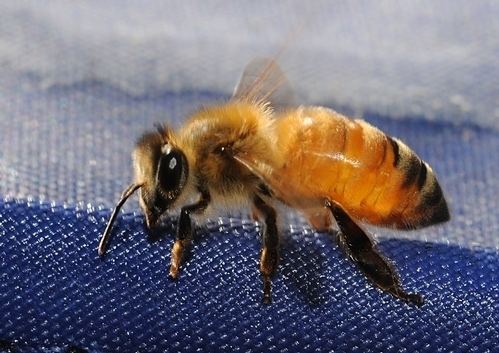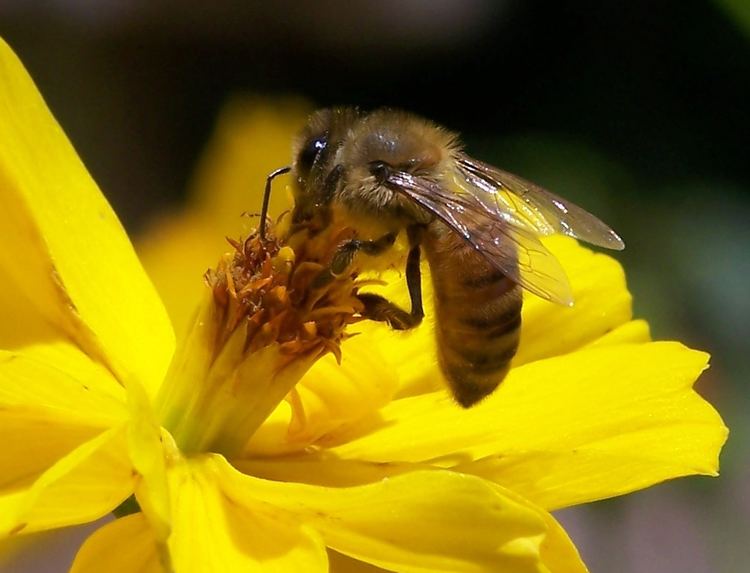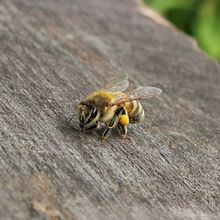Genus Apis | Scientific name Apis mellifera ligustica Rank Subspecies | |
 | ||
Similar Bee, Honey bee, Western honey bee, Carniolan honey bee, European dark bee | ||
Apis mellifera ligustica is the Italian bee which is a subspecies of the western honey bee (Apis mellifera).
Contents
Origin

The Italian honey bee is thought to originate from the continental part of Italy, south of the Alps, and north of Sicily. The subspecies may have survived the last Ice Age in Italy. It is genetically a different subspecies than that from the Iberian peninsula and from Sicily. It is the most widely distributed of all honey bees, and has proven adaptable to most climates from subtropical to cool temperate, but it is less successful in humid tropical regions. It is sometimes called the Ligurian bee.

Italian bees, having been conditioned to the warmer climate of the central Mediterranean, are less able to cope with the "hard" winters and cool, wet springs of more northern latitudes. They do not form such tight winter clusters. More food has to be consumed to compensate for the greater heat loss from the loose cluster. The tendency to raise broods late in autumn also increases food consumption. The noted beekeeper, Thomas White Woodbury, first introduced the Italian bee to Britain in 1859 and regarded it as vastly superior to the English Black.
Anatomy
Disease resistance
There is no clear evidence that A. m. ligustica is more resistant to acarine mites than the Northern dark bee. They also appear to be less tolerant of Nosema than Northern dark bees. They are unable to retain faeces in the gut for long periods and require more frequent cleaning flights than the dark bees. They are affected by the parasitic varroa mite, Tracheal Mites, and the bacterial diseases European Foulbrood, American Foul Brood, Chalkbrood and other diseases of the honey bee.
Characteristics
It has a reputation for gentleness, but hybrids with the darker races can be especially vicious.
Brother Adam, a bee breeder and developer of the Buckfast bee, characterized the Italian bee in his book Breeding the Honeybee:
From the commercial and breeding point of view the value of the Ligustica lies in a happy synthesis of a great number of good characteristics. Among these we must mention industry, gentleness, fertility, reluctance to swarm, zeal for building comb, white honey-cappings, a willingness to enter supers, cleanliness, resistance to disease, and the tendency to collect flower honey rather than honey dew. The last-named trait is of value only in countries where the colour of the honey determines the price. The Ligustica has shown that she is able to produce good crops from the red clover. In one other characteristic has the Ligustica proved exceptional and that is in her resistance to Acarine. This is especially true of the dark, leather-coloured variety, whereas the golden strains are highly susceptible to Acarine.
While the Italian bee has many strong points, among the A.m. ligustica it has a large number of weak points:
The Ligustica has her drawbacks, and these are serious. She lacks vitality and is inclined to excessive brood rearing. These two faults are the root cause of her other disadvantages. She has too a tendency to drift which is caused by a poor sense of orientation and this can prove a drawback where colonies are set out in rows facing in one direction as is the common practice in apiaries almost world-wide....
Curiously enough, all the above mentioned faults of the Ligustica appear in greatly emphasised form in the very light coloured strains, with an additional one, an unusually high consumption of stores. In European countries such strains have proved highly unsatisfactory as they tend to turn every drop of honey into brood. These light coloured varieties are likewise as already stated unusually susceptible to Acarine. The reason for this is not known in spite of all the work spent on trying to find it. It is all the more surprising when we consider that the dark, leather-coloured Ligustica has over a period of more than 60 years proved to be one of the most resistant to Acarine.
Strengths
Weaknesses
Foraging behavior
A. m. ligustica are more concerned with nectar processing behaviors, honey storage, and adult maintenance over brood expansion when compared to the African honey bee, A. m. scutellata.
Selective breeding
Breeders of Italian bees, as well as other honey bee races, look for certain beneficial characteristics. Depending on the breeding goal, one or more of the following characteristics may be emphasized:
- Gentleness or excitability
- Resistance to various diseases including tracheal mite and Varroa mite
- Early spring buildup in population
- Wintering ability
- Tendency to limited swarming
- Ability to ripen honey rapidly
- Honeycomb cappings are white
- Minimal use of propolis
- Availability and queen cost
- Color
Source: [1] George Imrie's pink pages
